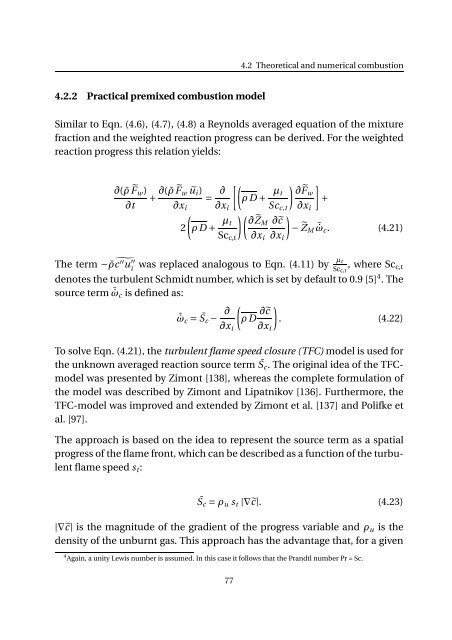Impact of fuel supply impedance and fuel staging on gas turbine ...
Impact of fuel supply impedance and fuel staging on gas turbine ...
Impact of fuel supply impedance and fuel staging on gas turbine ...
You also want an ePaper? Increase the reach of your titles
YUMPU automatically turns print PDFs into web optimized ePapers that Google loves.
4.2 Theoretical <str<strong>on</strong>g>and</str<strong>on</strong>g> numerical combusti<strong>on</strong><br />
4.2.2 Practical premixed combusti<strong>on</strong> model<br />
Similar to Eqn. (4.6), (4.7), (4.8) a Reynolds averaged equati<strong>on</strong> <str<strong>on</strong>g>of</str<strong>on</strong>g> the mixture<br />
fracti<strong>on</strong> <str<strong>on</strong>g>and</str<strong>on</strong>g> the weighted reacti<strong>on</strong> progress can be derived. For the weighted<br />
reacti<strong>on</strong> progress this relati<strong>on</strong> yields:<br />
∂( ¯ρ ˜F w )<br />
+ ∂( ¯ρ ˜F w ũ i )<br />
∂t ∂x i<br />
(<br />
2<br />
= ∂ [(<br />
ρ D+ µ ) ]<br />
t ∂˜F w<br />
+<br />
∂x i Sc c,t ∂x i<br />
ρ D+ µ t<br />
Sc c,t<br />
)( ∂ ˜Z M<br />
∂x i<br />
)<br />
∂˜c<br />
− ˜Z M ¯˙ω c . (4.21)<br />
∂x i<br />
The term − ¯ρ c ′′ u ′′<br />
i<br />
was replaced analogous to Eqn. (4.11) by µ t<br />
Sc c,t<br />
, where Sc c,t<br />
denotes the turbulent Schmidt number, which is set by default to 0.9 [5] 4 . The<br />
source term ¯˙ω c is defined as:<br />
¯˙ω c = S¯<br />
c − ∂ (<br />
ρ D ∂˜c )<br />
. (4.22)<br />
∂x i ∂x i<br />
To solve Eqn. (4.21), the turbulent flame speed closure (TFC) model is used for<br />
the unknown averaged reacti<strong>on</strong> source term S¯<br />
c . The original idea <str<strong>on</strong>g>of</str<strong>on</strong>g> the TFCmodel<br />
was presented by Zim<strong>on</strong>t [138], whereas the complete formulati<strong>on</strong> <str<strong>on</strong>g>of</str<strong>on</strong>g><br />
the model was described by Zim<strong>on</strong>t <str<strong>on</strong>g>and</str<strong>on</strong>g> Lipatnikov [136]. Furthermore, the<br />
TFC-model was improved <str<strong>on</strong>g>and</str<strong>on</strong>g> extended by Zim<strong>on</strong>t et al. [137] <str<strong>on</strong>g>and</str<strong>on</strong>g> Polifke et<br />
al. [97].<br />
The approach is based <strong>on</strong> the idea to represent the source term as a spatial<br />
progress <str<strong>on</strong>g>of</str<strong>on</strong>g> the flame fr<strong>on</strong>t, which can be described as a functi<strong>on</strong> <str<strong>on</strong>g>of</str<strong>on</strong>g> the turbulent<br />
flame speed s t :<br />
¯ S c = ρ u s t |∇˜c|. (4.23)<br />
|∇˜c| is the magnitude <str<strong>on</strong>g>of</str<strong>on</strong>g> the gradient <str<strong>on</strong>g>of</str<strong>on</strong>g> the progress variable <str<strong>on</strong>g>and</str<strong>on</strong>g> ρ u is the<br />
density <str<strong>on</strong>g>of</str<strong>on</strong>g> the unburnt <strong>gas</strong>. This approach has the advantage that, for a given<br />
4 Again, a unity Lewis number is assumed. In this case it follows that the Pr<str<strong>on</strong>g>and</str<strong>on</strong>g>tl number Pr = Sc.<br />
77
















